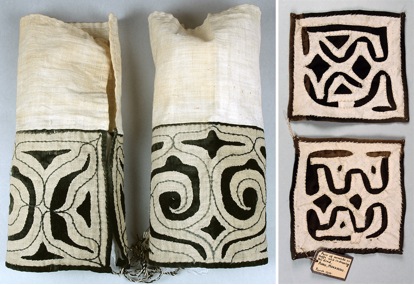Leg and arm cloths for the dead
Ainu people, Japan
 Purchased from the Ainu village Japanese-British Exhibition in 1910; 1910.68.36–.37The Ainu are a group of hunter-gathers ethnically distinct from the Japanese. Historically they lived on the Kuril Islands which linked far eastern Russia with Hokkaido, the northern island of Japan, but they now reside only in the northern part of Hokkaido and southern area of the island of Sakhalin.
Purchased from the Ainu village Japanese-British Exhibition in 1910; 1910.68.36–.37The Ainu are a group of hunter-gathers ethnically distinct from the Japanese. Historically they lived on the Kuril Islands which linked far eastern Russia with Hokkaido, the northern island of Japan, but they now reside only in the northern part of Hokkaido and southern area of the island of Sakhalin.
These armlets and leggings are part of a costume used by the Ainu for dressing the dead. A set would always be ready-made and kept in case of a sudden death. The white calico cloth is likely to have been favoured as a symbol of purity as the deceased enters a new world unencumbered by the past, rather than having any association with the Japanese use of white as a mourning colour.
The Ainu decorate their clothing with appliqué and embroidery. These leggings have a black dyed patch stitched to the white cloth and on top of this is a third layer of white cloth; a cut-out design embroidered with couching, stem stitch, and chain stitch. The leggings are laced around the deceased's lower legs whilst the armlet patches are placed near the wrist. The Ainu decorate their clothes with web-like and symmetrical motifs to protect against evil and provide good luck. This explains why these items are placed at hems, collars and sleeve ends which are vulnerable openings where evil forces may enter.
The Ainu also orient their lives around the direction of sunrise and sunset. The dying sun is linked to death and because the sun sets over the sea, the world of the dead is thought to be located somewhere on the shore. The clothes of a deceased person have to be disposed of outside the wall of the house that faces the sunset. The dressed body is laid in front of a fire on a special mat called a kina, the head in the direction of the sunset. Prayers are said, wine is drunk and relatives and friends place small gifts and food by the body. Afterwards the body is wrapped in the kina and taken for burial at a spot chosen by the relatives, sometimes high up in the mountains. The deceased is carried out feet first to ensure that he or she will not look back into the house and hesitate to leave.
At the funeral itself, the body is again positioned so that the head faces sunset. The male mourners usually trim their beards and shave their foreheads. Traditionally a widow also shaved her head – originally with sharpened shells and later with Japanese razors – and wore a widow's bonnet until she married again or, if she was elderly, until the end of her life.
